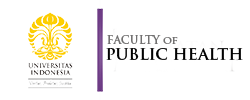Hubungan Tingkat Berat Jenis Urin dengan Keluhan/Gangguan Kesehatan akibat Pajanan Panas pada Pekerja Konstruksi Depo LRT
Abstract
Keywords
References
ACGIH. (2013). Heat Stress and Strain: TLV Physical Agents Documentation. Cincinatti, OH: American Conference of Governmental Industrial Hygienists.
Atha, W. F. (2013). Heat-related illness. Emergency Medicine Clinics, 31(4), 1097-1108.
Bates, G. P., & Schneider, J. (2008). Hydration status and physiological workload of UAE construction workers: A prospective longitudinal observational study. Journal of Occupational Medicine and Toxicology, 3(1), 1–10. https://doi.org/10.1186/1745- 6673-3-21
Benton, D., Young, H., & Jenkins, K. (2015). The development of the predisposition to dehydration questionnaire. Appetite, 87, 76-80.
Brake, D. J. (2002). The deep body core temperatures, physical fatigue and fluid status of thermally stressed workers and the development of thermal work limit as an index of heat stress (Doctoral dissertation, Curtin University).
Cengel, Y.A. (2002) Heat Transfer: A Practical Approach. 2nd Edition, McGraw-Hill, New York.
Cheuvront, S. N., Kenefick, R. W., Charkoudian, N., & Sawka, M. N. (2013). Physiologic basis for understanding quantitative dehydration assessment. The American journal of clinical nutrition, 97(3), 455-462.
El-Shafei, D. A., Bolbol, S. A., Awad Allah, M. B., & Abdelsalam, A. E. (2018). Exertional heat illness: Knowledge and behavior among construction workers. Environmental Science and Pollution Research International, 25(32), 32269-32276. https://doi.org/10.1007/s11356-018-3211-8
Flouris, A. D., Dinas, P. C., Ioannou, L. G., Nybo, L., Havenith, G., Kenny, G. P., & Kjellstrom, T. (2018). Workers’ health and productivity under occupational heat strain: a systematic review and meta-analysis. The Lancet Planetary Health, 2(12), e521–e531. https://doi.org/10.1016/S2542-5196(18)30237-7
Gammons, M., Bolognani, T., & Howland, M. (2016). Evaluation and Treatment of Heat and Altitude-Related Illness. Endurance Sports Medicine: A Clinical Guide, 31-41.
Gauer, R. L., & Meyers, B. K. (2019). Heat-related illnesses. American family physician, 99(8), 482-489.
Haq, K., & Patel, D. M. (2023). Urinalysis: Interpretation and Clinical Correlations. Medical Clinics, 107(4), 659-679.
Isaksen, T. B., Fenske, R. A., Hom, E. K., Ren, Y., Lyons, H., & Yost, M. G. (2016). Increased mortality associated with extreme-heat exposure in King County, Washington, 1980–2010. International journal of biometeorology, 60, 85-98.
ISO. (2004). Ergonomics of the thermal environment—analytical determination and interpretation of heat stress using calculation of the predicted heat strain (ISO 7933:2004). London: The British Standards Institution.
Jamaluddin (2018) Perpindahan Panas dan Massa pada Penyangraian dan Penggorengan Bahan Pangan. Edisi Pertama. Makassar, Indonesia: Badan Penerbit Universitas Negeri Makassar.
Khan, A. A. (2019). Heat related illnesses: Review of an ongoing challenge. Saudi Medical Journal, 40(12), 1195–1201. https://doi.org/10.15537/smj.2019.12.24727
Kothandaraman, C.P. (2006) Fundamentals of Heat and Mass Transfer. 3rd Edition. New Delhi, India: New Age International (P) Ltd., Publishers.
Luangwilai, T., Robson, M. G., & Siriwong, W. (2021). Effect of heat exposure on dehydration and kidney function among sea salt workers in Thailand. Roczniki Panstwowego Zakladu Higieny, 72(4), 435–442. https://doi.org/10.32394/rpzh.2021.0186
Nainggolan, G., Soemarko, D., Siregar, P., Sutranto, A. L., Bardosono, S., Prijanti, A. R., & Aulia, Di. (2021). Diagnostic role of urine specific gravity to detect kidney impairment on heat-exposed workers in a shoe factory in Indonesia: A cross-sectional study. BMJ Open, 11(9), 1–8. https://doi.org/10.1136/bmjopen-2020- 047328
Nerbass, F. B., Pecoits-Filho, R., Clark, W. F., Sontrop, J. M., McIntyre, C. W., & Moist, L. (2017). Occupational heat stress and kidney health: from farms to factories. Kidney international reports, 2(6), 998-1008.
Karthick, S., Kermanshachi, S., & Pamidimukkala, A. (2022). Impact analysis of heat on physical and mental health of construction workforce. In International Conference on Transportation and Development 2022 (pp. 290-298).
Mankiw, N. G. (2003). Macroeconomics. New York: Worth.
Montazer, S., Farshad, A. A., Monazzam, M. R., Eyvazlou, M., Yaraghi, A. A. S., & Mirkazemi, R. (2013). Assessment of construction workers’ hydration status using urine specific gravity. International journal of occupational medicine and environmental health, 26, 762-769. https://doi.org/10.2478/s13382-013-0143-x
Palupi, A. A. R., Rizky, Z. P., Puspita, N., Atmajaya, H., Ramdhan, D. H. (2017). Physiological and Psychological Effects of Heat Stress on Automotive Manufacture Workers. The 1st International Conference on Global Health, KnE Life Sciences, pages 149-155. DOI 10.18502/kls.v4i1.1376.
Parsons, K.C., Havenith, G., Holmér, I., Nilsson, H., Malchaire, A.J., (1999) The effects of wind and human movement on the heat and vapour transfer properties of clothing. Annals of Occupational Hygiene, 43 (5), 347–352.
Presta, V., Ambrosini, L., Carubbi, C., Masselli, E., Mirandola, P., Arcari, M. L., ... & Vitale, M. (2021). Different waters for different performances: can we imagine sport-related natural mineral spring waters?. Water, 13(2), 166.
Rowlinson, S., Yunyanjia, A., Li, B., & Chuanjingju, C. (2014). Management of climatic heat stress risk in construction: A review of practices, methodologies, and future research. Accident Analysis and Prevention, 66, 187–198. https://doi.org/10.1016/j.aap.2013.08.011
Rowlinson, S., & Jia, Y. A. (2015). Construction accident causality: An institutional analysis of heat illness incidents on site. Safety Science, 78, 179–189. https://doi.org/10.1016/j.ssci.2015.04.021
Rutherford, D. (1995). Routledge dictionary of economics. Taylor & Francis.
Savoie, F. A., Kenefick, R. W., Ely, B. R., Cheuvront, S. N., & Goulet, E. D. (2015). Effect of hypohydration on muscle endurance, strength, anaerobic power and capacity and vertical jumping ability: a meta-analysis. Sports medicine, 45, 1207- 1227.
Shaheen, N. A., Alqahtani, A. A., Assiri, H., Alkhodair, R., & Hussein, M. A. (2018). Public knowledge of dehydration and fluid intake practices: variation by participants’ characteristics. BMC public health, 18(1), 1-8.
Simerville, J.A., Maxted, W.C. and Pahira, J.J. (2005) Urinalysis: A Comprehensive Review. American Family Physician, 71.
Winanda, L. A. R., Adi, T. W., & Anwar, N. (2017). Model prediksi kelelahan pekerja konstruksi di lokasi proyek. J JITS Udayana.
Vitharana, V. H. P., De Silva, G. H. M. J., & De Silva, S. (2015). Health hazards, risk and safety practices in construction sites–a review study. Engineer: Journal of the Institution of Engineers, Sri Lanka, 48(3)
DOI: 10.59230/njohs.v4i2.7643
Refbacks
- There are currently no refbacks.







.png)
